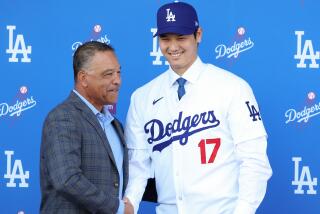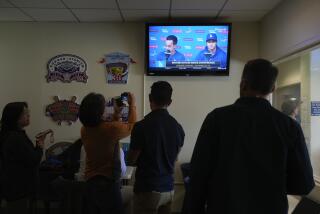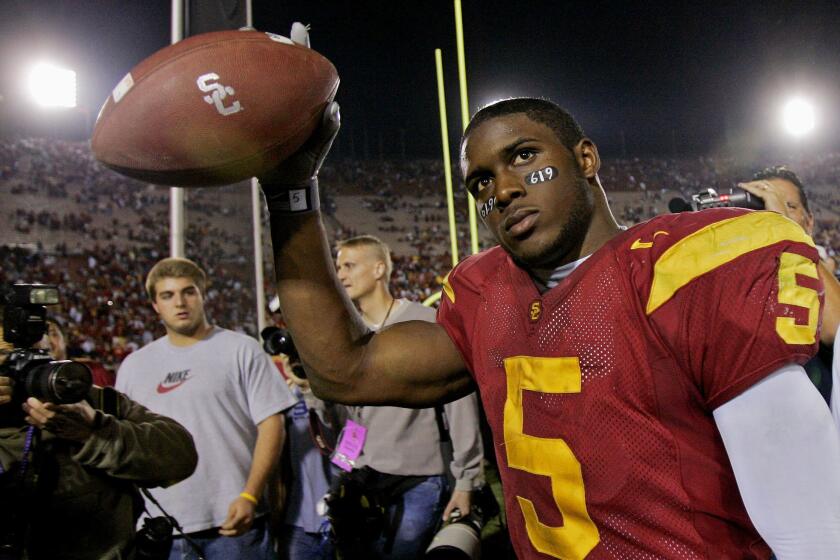Japanese teen’s triple-digit fastball has some calling him the next Shohei Ohtani
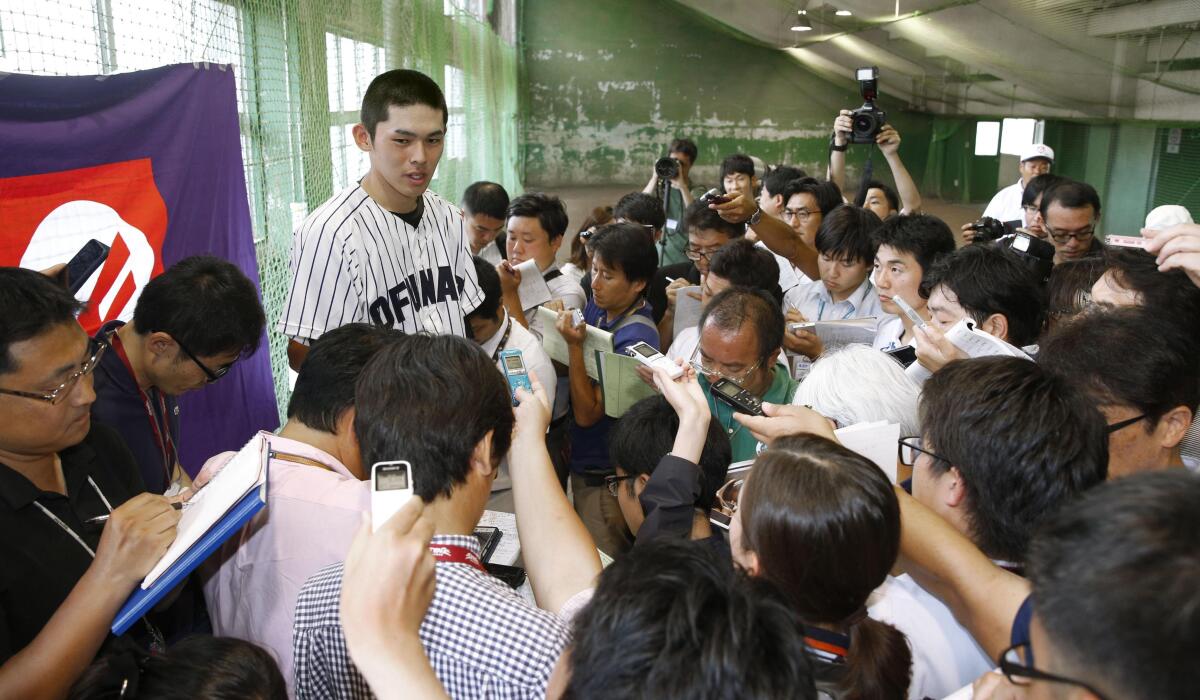
Synchronized cheers reverberated through the bowels of the stadium, the sounds of a tournament in progress. The noise reached all the way to an indoor batting cage down the left-field line, where the hero of an earlier ballgame was dutifully ushered to a makeshift news conference.
Though at 6-feet-2 he was an entire head taller than anyone else in the room, Rouki Sasaki was nonetheless asked by a tournament official to stand on a wooden box that was placed on the dirt floor. He obliged, removed his cap and bowed.
The elevated platform was necessary to make the lanky right-hander visible to reporters on the outer rings of the semicircle that formed for his post-game address. More than 100 journalists had been dispatched to the backwoods of northern Japan’s mainland to chronicle the first summer start of a 17-year-old high school senior who overcame a family tragedy to become the next Shohei Ohtani.
Japan has an obsession with high school baseball, particularly the prefecture and national tournaments in the summer, but the scene still qualified as extraordinary. It was only the first round of the Iwate prefecture tournament. Sasaki wasn’t even expected to pitch as his Ofunato High team played a small school from a small town.
As it turned out, he went the first two innings of a 14-0 victory that was called after five innings because of a mercy rule. Sasaki estimated that he threw at 60% effort, which explained why his fastball hadn’t come near the 101 mph it had been clocked at three months earlier in breaking Ohtani’s national high school record for velocity.
“Not even this much was made of Ohtani at the start of the tournament,” said Hisatoshi Kato, a radio broadcaster who has called high school games in Iwate for four decades. “Yusei Kikuchi emerged from this area 10 years ago. Shohei Ohtani emerged a few years later. Now, people are saying this kid might be better than those two.”
Kikuchi, a left-hander, is a former star in Japan’s top league who pitches for the Seattle Mariners. Ohtani was a stellar two-way performer in Nippon Professional Baseball — a right-hander with a triple-digit fastball and slugger with prodigious home-run power — before signing with the Angels and becoming the 2018 American League rookie of the year.
Sasaki’s 19-pitch performance was the lead story the following day in Japan’s daily sports newspapers, and his talent was only part of the reason.
The teenager is more than a symbol of Japan’s expanding athletic ambitions, which in recent years has sent Ohtani to the Major League Baseball, teenage soccer prodigy Takefusa Kubo to Spanish powerhouse Real Madrid, and biracial basketball star Rui Hachimura to the NBA.
As a former resident of the coastal town Rikuzentakata, Sasaki also represents the recovery of the Tohoku region that was devastated by an earthquake and tsunami in 2011.
When Sasaki was 9, the tsunami claimed the life of his father, according to multiple reports. He lost a set of grandparents as well.
His widowed mother moved him and his two brothers about 10 miles up the coast to Ofunato. As his older brother became Ofunato High’s cleanup hitter, Sasaki emerged as a national-level player in middle school, which led to him receiving offers from powerhouse high schools throughout the country.
Kikuchi had spurned similar offers to remain in Iwate to play for Hanamaki Higashi High. His heroics on the national stage inspired Ohtani to follow him to the same school.
Sasaki went a step further: He not only remained in Iwate, but also stayed on the coast. He wanted to continue playing with the teammates who supported him as he and his family rebuilt their lives.
“This is the final tournament with this team,” Sasaki said. “I want to end with us winning together. That was what I had in mind when I chose this school.”
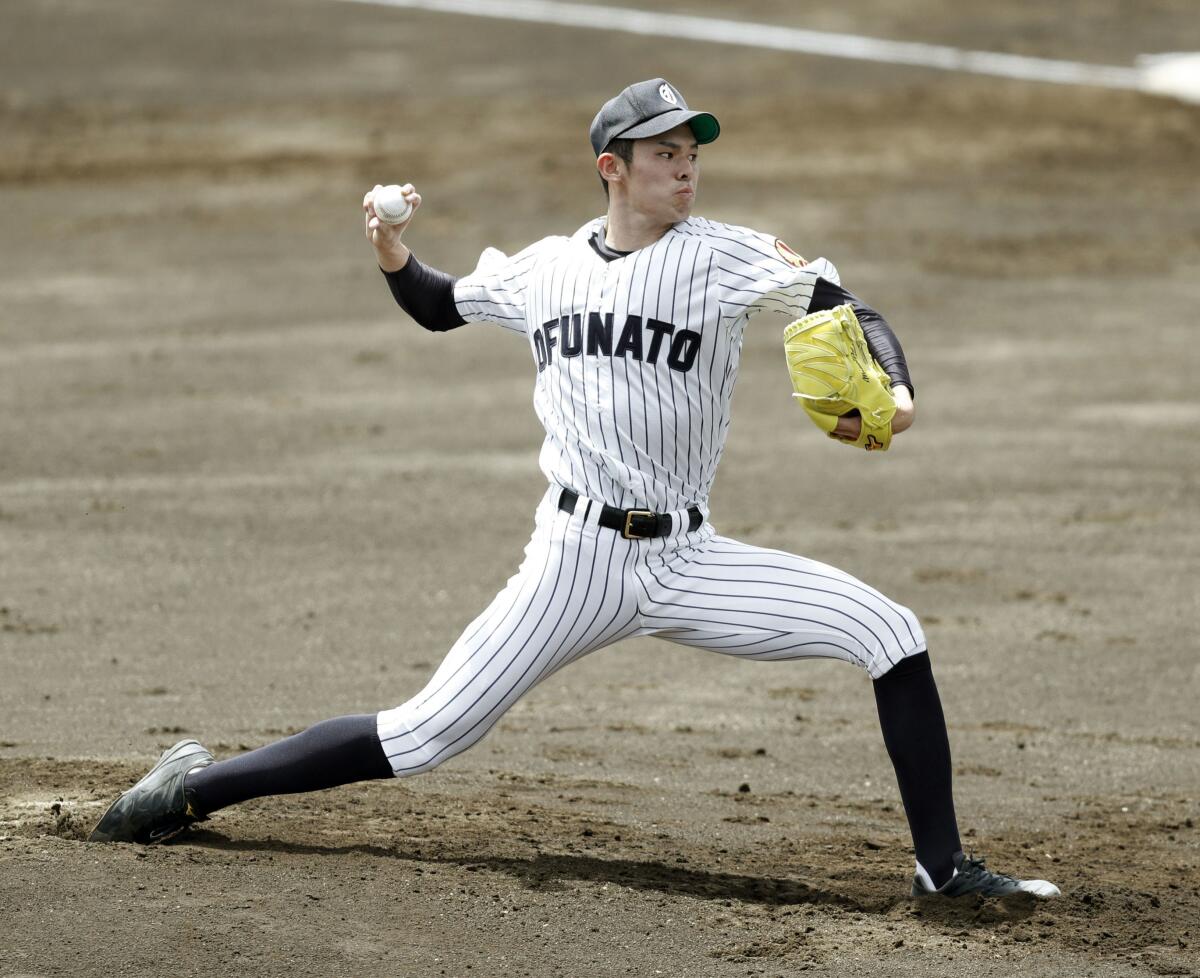
Despite some memorable performances by Sasaki in recent weeks, Ofunato failed to advance to the national tournament. In the school’s second game of the Iwate tournament, he pitched a six-inning no-hitter. Sasaki followed that with a 12-inning complete game in which he struck out 21, threw 194 pitches and blasted a game-winning two-run home run.
He was rested in quarterfinals, then struck out 15 in a complete-game victory in the next round. The prefecture championship game was played the day after the semifinals and Ofunato elected to do something unusual for a Japanese high school team: It allowed its ace some rest, prioritizing his future over its own ambitions.
With Sasaki on the bench, Ofunato was wiped out by Hanamaki Higashi, Ohtani’s alma mater.
Sasaki and his team started the tournament in the same stadium where Ohtani was clocked at 99 mph as a high school senior.
The entrance of Hanamaki Stadium features a shrine to the local school’s baseball team. Championship banners and certificates won by Hanamaki Higashi are exhibited in a display case, as are autographs of alumni who went on to play professionally, including Ohtani and Kikuchi.
The stadium is part of an athletic complex that borders Hanamaki Higashi High. A green equipment shed by the school’s all-dirt practice field is decorated with plaques recognizing donors. Ohtani and Kikuchi are remembered here, too.
As Ofunato prepared for its opening game, Hanamaki Higashi prepared for its next game by taking infield practice that looked as if it would never end. Hiroshi Sasaki, the manager who once made Ohtani and Kikuchi clean toilets as part of their education, batted fungoes nonstop for more than half an hour.
Hanamaki Higashi was looking toward a potential showdown in the prefecture final against Sasaki, a pitcher who most resembled their most famous graduate.
Sasaki and Ohtani have similar body types. They both run exceptionally well for their size.
Sasaki bats cleanup for Ofunato, just as Ohtani once did for Hanamaki Higashi. But whereas Japanese and major league teams debated whether Ohtani should be a pitcher or hitter — the Nippon-Ham Fighters eventually decided he should be both — Sasaki’s future unquestionably is on the mound.
Using a windup that includes a high leg kick, Sasaki looks as graceful pitching as Ohtani does hitting.

“The fact that he can lift his leg that high and maintain control of his body shows he has a high level of skill,” said Yutaka Wada, a former player who is technical advisor for the Hanshin Tigers of the Japanese league. “His breaking pitches have good bite and he has good control. He’s a premium product.”
Shortly after Sasaki delivered a pitch that was clocked at 101 mph at a youth national team camp in April, he declared his intention of signing with a Japanese league team out of high school. The Nippon-Ham Fighters have already said they would use their first-round selection in the October draft on Sasaki. If, as expected, multiple teams select him, one of them will be awarded his rights via a lottery.
But plans can change and some Nippon Professional Baseball officials privately expressed concerns that Sasaki could be poached by a major league team. The Dodgers are one of several teams who are known to have scouted him.
As Ohtani showed, players this age can be talked out of their plans. As a high school senior, Ohtani was closely linked to the Dodgers and made public his intentions of signing with a major league team. The Fighters convinced him to remain in Japan by offering him a chance to play both ways; the Dodgers were planning to develop him only as a pitcher.
One major league scout monitoring the situation said he had no idea whether there was a chance Sasaki could be persuaded to move to the United States out of high school.
“We cannot get access to the kid,” said the scout, who spoke under the condition of anonymity because his team forbids him from publicly commenting on amateur players.
Ofunato High has forbidden visitors setting foot on campus after Sasaki unleashed that 101 mph fastball. The rule also applies to journalists, whose access to Sasaki has been restricted to post-game news conferences in the summer prefecture tournament.
But those limitations haven’t kept him from becoming one of the country’s most talked-about athletes. Japan believes in his talent and has made an emotional investment in his story.
Sometime in the future, the United States could, too.
More to Read
Get our high school sports newsletter
Prep Rally is devoted to the SoCal high school sports experience, bringing you scores, stories and a behind-the-scenes look at what makes prep sports so popular.
You may occasionally receive promotional content from the Los Angeles Times.

